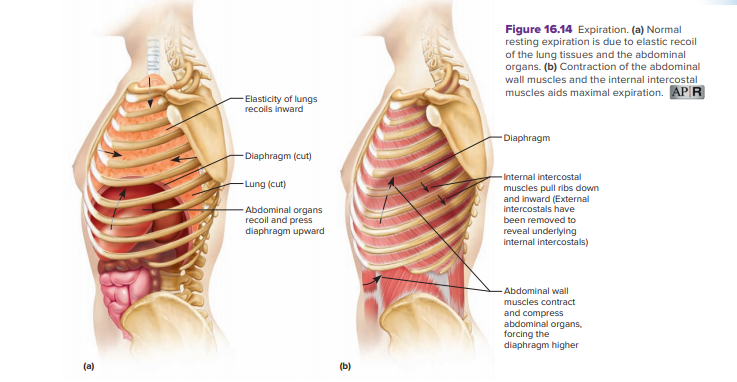The forces for resting expiration come from the elastic recoil of tissues and from surface tension. The lungs contain considerable elastic tissue, which stretches with lung expansion during inspiration. As the diaphragm and external intercostal muscles relax following inspiration, the elastic tissues cause the lungs to recoil and return to their original shapes. This pulls the visceral pleural membrane inward, and the parietal pleura and chest wall follow. Also, during inspiration the diaphragm compresses the abdominal organs beneath it. When the diaphragm relaxes, the abdominal organs spring back into their previous shapes, pushing the diaphragm upward (fig. 16.14a). At the same time, the surface tension that develops on the moist surfaces of the alveolar linings decreases the diameters of the alveoli. Together these factors increase intra-alveolar pressure about 1 mm Hg above atmospheric pressure, so that the air inside the lungs is forced out through respiratory passages with no muscle action. Thus, normal resting expiration is a passive process. If a person needs to exhale more air than normal, the internal (expiratory) intercostal muscles can contract (fig. 16.14b). These muscles pull the ribs and sternum downward and inward, increasing the air pressure in the lungs to force more air out. Also, the abdominal wall muscles, including the external and internal obliques, transversus abdominis, and rectus abdominis, can squeeze the abdominal organs inward (see fig. 8.20). In this way, the abdominal wall muscles can increase pressure in the abdominal cavity and force the diaphragm still higher against the lungs. These actions force additional air out of the lungs. Clinical Application 16.1 discusses problems in breathing associated with two common diseases, emphysema and lung cancer
The forces for resting expiration come from the elastic recoil of tissues and from surface tension. The lungs contain considerable elastic tissue, which stretches with lung expansion during inspiration. As the diaphragm and external intercostal muscles relax following inspiration, the elastic tissues cause the lungs to recoil and return to their original shapes. This pulls the visceral pleural membrane inward, and the parietal pleura and chest wall follow. Also, during inspiration the diaphragm compresses the abdominal organs beneath it. When the diaphragm relaxes, the abdominal organs spring back into their previous shapes, pushing the diaphragm upward
(fig. 16.14a). At the same time, the surface tension that develops on the moist surfaces of the alveolar linings decreases the diameters of the alveoli. Together these factors increase intra-alveolar pressure about 1 mm Hg above atmospheric pressure, so that the air inside the lungs is forced out through respiratory passages with no muscle action. Thus, normal
resting expiration is a passive process. If a person needs to exhale more air than normal, the internal (expiratory) intercostal muscles can contract
(fig. 16.14b). These muscles pull the ribs and sternum downward and inward, increasing the air pressure in the lungs to force more air out. Also, the abdominal wall muscles, including the external and internal obliques, transversus abdominis, and rectus abdominis, can squeeze the abdominal organs inward (see fig. 8.20). In this way, the abdominal wall muscles can increase pressure in the abdominal cavity and force the diaphragm still higher against the lungs. These actions force additional air out of the lungs. Clinical Application 16.1 discusses problems in breathing associated with
two common diseases, emphysema and lung cancer

Trending now
This is a popular solution!
Step by step
Solved in 2 steps









